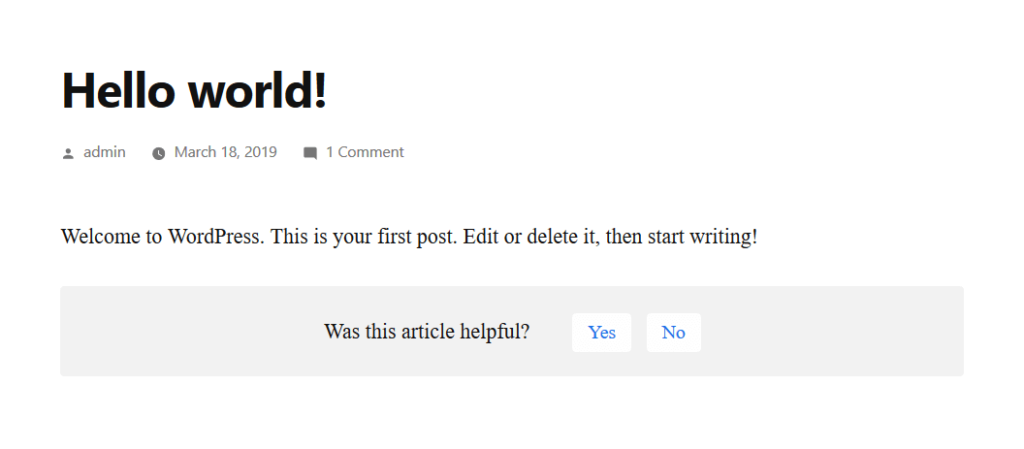Crafting exceptional user experiences with WordPress UX


Positive user experiences (UX) can be the determining factor in successfully attracting and retaining customers. When it comes to website creation, WordPress offers a dynamic platform ripe with customizable options to fashion extraordinary UX designs. In this comprehensive and in-depth guide, we delve into the fundamental principles and effective strategies for crafting top-notch user experiences with WordPress UX.
What is user experience?
User experience (UX) refers to the overall interaction a person has with a product, system, or service. In the context of websites, UX encompasses how users navigate, interact with, and feel about a site. It’s not just about aesthetics; it’s about creating a seamless, intuitive, and enjoyable journey for visitors as they explore your WordPress site.
Good UX design considers various elements, including:
- Usability – how easy and efficient it is for users to accomplish their goals on your site.
- Accessibility – ensuring your site is usable by people with diverse abilities.
- Performance – the speed and responsiveness of your website.
- Information architecture – how content is organized and presented.
- Visual design – the look and feel of your site, including color schemes, typography, and imagery.
Harnessing the strength of WordPress UX
WordPress is renowned for its versatility and customization capabilities, equipping businesses with the tools to create captivating and user-friendly websites. The broad range of themes, plugins, and other customization options offered by WordPress allows you to create a tailor-made user experience that addresses your unique needs.
By fully utilizing the power of WordPress UX, you can design websites that are visually alluring and offer effortless navigation, intuitive interfaces, and content that adds value to the user’s experience.

Understanding the fundamentals of UX design is crucial before delving into the particulars of WordPress UX. At the heart of UX design lies the concept of user-centered design, which allows you to understand users’ objectives, behaviors, and requirements. Empathizing with your target demographic allows you to design interfaces and experiences that align with their expectations and preferences.
Furthermore, usability and accessibility are vital components of UX design, ensuring that your website is user-friendly and easily accessible to all users, including those with disabilities.
Incorporating empathy and user research in WordPress UX
Crafting exceptional user experiences with WordPress necessitates empathy towards your users and a profound understanding of their preferences and behaviors. Undertaking user research through techniques like surveys, interviews, and usability testing can yield valuable insights and provide crucial feedback. This understanding can shed light on the goals and challenges faced by your target audience. Integrating user feedback into your design process allows for iterative improvement of the UX of your WordPress website, enhancing user satisfaction and engagement.
Creating intuitive interfaces is pivotal to a seamless and enjoyable user experience. While designing your WordPress website, prioritize constructing clear and logical navigation menus that guide users effortlessly through your site. Incorporating consistent and intuitive interface elements, such as buttons and icons, can augment usability and facilitate easier user interaction with your website. Principles of information architecture should guide the organization of your content to enhance ease of navigation and comprehension.

Optimizing user navigation
Providing effective user navigation is crucial to a positive UX. WordPress offers an array of tools and strategies to optimize user navigation on your website. Utilize features like breadcrumbs, a visual navigation aid that outlines the user’s current location on the page, to provide context and assist users in navigating back to prior pages. Implementation of a search functionality can empower users to locate the information they seek swiftly.
By fine-tuning user navigation, you can decrease friction, streamline user flow, and elevate the overall user experience.
Structuring content for user-friendly experiences
Organizing your content is vital for delivering a user-friendly experience on your WordPress website. Structure your content logically, using headings and subheadings to establish a clear information hierarchy. Utilize tools such as bullet points, tables, and images to break down extensive blocks of text and enhance content scannability. A consistent formatting style across your website contributes to visual cohesion and bolsters readability.
Adopting responsive design for many devices
In the era of mobile prevalence, ensuring that your WordPress website delivers a stellar user experience across all devices is non-negotiable. Responsive design allows your website to adjust and display seamlessly across various screens, from desktop monitors to tablets and smartphones.
WordPress offers numerous responsive themes and plugins that adjust your website’s layout based on the user’s screen size. This ensures that your site remains visually appealing and functionally efficient, irrespective of the device used for access.
Fostering accessibility in design
Creating an inclusive user experience is paramount in UX design. With WordPress, you can employ various plugins and best practices to make your website accessible to a wide range of users, including those with visual, auditory, or physical impairments. Tools like WP Accessibility can help you add skip links, ARIA landmarks, and fix common accessibility issues.
Remember, an accessible website not only reaches a wider audience but also improves SEO performance, as search engines often prioritize websites that adhere to accessibility standards.
Leveraging the power of WordPress plugins
Plugins can significantly enhance your site’s functionality and user experience. Whether it’s adding a contact form, improving site speed, or integrating social media, there’s likely a WordPress plugin that can do the job. While plugins can significantly improve your site’s UX, it’s essential to keep them updated and use them judiciously, as too many can slow down your site. Therefore, carefully select the plugins that truly add value to your site’s user experience.
Brizy Website Builder
Brizy is a WordPress page builder plugin that provides an intuitive interface for creating stunning web pages without needing to write any code. It offers a user-friendly, drag-and-drop editor that simplifies the web design process, making it accessible for people of all skill levels.
In terms of improving WordPress UX, Brizy is invaluable. Its easy-to-use interface and design flexibility allow website developers to create more attractive, user-friendly sites. Its rich set of customization options and pre-made designs enable the creation of unique, engaging pages that enhance user engagement and satisfaction. Furthermore, its responsive design features ensure a seamless experience for users, whether they’re browsing on a desktop, tablet, or mobile device.
WooCommerce Better Usability
WooCommerce Better Usability (WBU) is a WordPress plugin designed to enhance the usability and customer experience of WooCommerce-based online stores. As WooCommerce is one of the most popular e-commerce platforms for WordPress, WBU is often essential for businesses selling products or services online.
WBU enhances the display of product variations by replacing the standard drop-down selection with more visually appealing and user-friendly buttons. This makes it easier for customers to see and select the product variants they want.
The combination of these features makes WBU a powerful tool for improving WordPress UX, particularly for e-commerce sites. By streamlining the shopping process, reducing the number of clicks and page refreshes, and enhancing the display of product information, WBU can make online shopping a more enjoyable experience, leading to increased customer satisfaction and potentially boosting sales.
Was This Helpful?
Was This Helpful? by WaspThemes is a WordPress plugin that gives website owners and administrators the ability to collect feedback from visitors about the quality or usefulness of their content. This simple tool adds a feedback section, typically at the end of posts or pages, asking the user whether the content was helpful or not.

This plugin can improve WordPress UX in several ways. First, it gives users a direct means of interaction with the website, making them feel more engaged and valued. Users are more likely to return to a site if they feel their input is appreciated and considered.
The data collected from the Was This Helpful? plugin can provide valuable insights into what users find valuable on your website. This feedback can help you improve the content on your site to meet your audience’s needs and preferences better. If specific posts are consistently marked as not helpful, this might indicate that the content needs to be updated, clarified, or presented differently.
Read our full roundup of the best WordPress plugins for design.
Keeping UX in mind for website maintenance
The user experience should remain a priority, even during website maintenance and updates. WordPress provides maintenance modes and plugins that can show a friendly message or a sleekly designed page instead of an error message during downtime. Keeping your users informed and maintaining a polished, professional appearance even during updates is an integral part of the overall user experience.
By following these comprehensive steps, including empathizing with users, creating intuitive interfaces, ensuring effective navigation, organizing content wisely, and implementing responsive design, you can harness the full potential of WordPress UX. To learn more about applying robust UX design to inbound users and traffic, check out our guide to creating successful landing pages.
